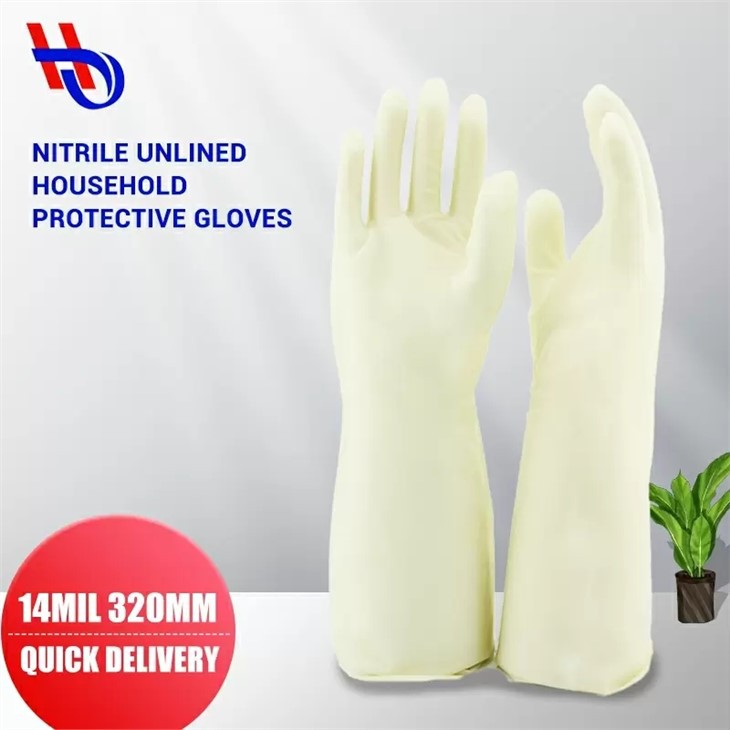Nitrile Gloves
What is Nitrile Gloves
Nitrile gloves are crafted from a synthetic mixture of acrylonitrile and butadiene. This unique blend strikes the perfect balance between flexibility and strength. For instance, in the food processing industry, workers handling both raw and cooked items prefer nitrile gloves because they provide the necessary dexterity for delicate tasks, like deboning fish, while ensuring safety from potential contaminants.
Advantages of Nitrile Gloves
Strong barrier protection: Nitrile gloves have high tensile strength and greater barrier protection against bloodborne pathogens and hazardous contaminants. This strong barrier protection is a result of nitrile's advanced puncture resistance properties. Nitrile gloves are the most durable option available for medical and industrial use.
High puncture resistance: Nitrile gloves offer high abrasion resistance and are three to five times more puncture resistant than latex alternatives. Because nitrile rubber is highly puncture-resistant, nitrile gloves are preferred when there's a high exposure risk to bloodborne pathogens or infection.
Greater chemical resistance: Nitrile rubber provides reliable resistance to chemicals, acids and petroleum-based liquids. This resistance covers any oils, fuels, alcohols, hydraulic fluids and silicone greases workers may encounter in high-risk industrial environments.
Latex-free: Nitrile is a dependable, hypoallergenic alternative for people suffering from latex allergies. Staff members with latex allergies can work safely and comfortably in nitrile gloves. When workers wear nitrile gloves, contact between the wearer and the patients or products they handle will have no risk of causing latex reactions.
Comfortable fit: Nitrile gloves conform to the wearer's hands for a snug and comfortable fit. Nitrile gloves limit exposure risks by ensuring the protective material covers the skin thoroughly. When handling hazardous or corrosive chemicals, nitrile gloves offer a strong barrier over the skin and prevent contaminants from getting underneath the glove, too.
Tactile sensitivity: Nitrile gloves offer decent tactile sensitivity so workers can handle tools and procedures with the necessary precision. Workers can withstand harsh applications while maintaining an appropriate level of dexterity. Their lower coefficient of friction also ensures an easy donning and doffing process.
Temperature resistance: Nitrile rubber remains functional in conditions ranging from minus 40 degrees to 226 degrees Fahrenheit. This property is beneficial for applications involving hot oils and chemical reactions where workers can expect extreme temperatures.
Nontoxic: Nitrile gloves are food safe with thicknesses up to 3 millimeters for food service regulations. Nitrile's nontoxic and latex-free properties allow for safe use in food service industries across the United States.
Waterproof: Nitrile gloves provide a secure grip in wet and dry conditions. Waterproof gloves are ideal for many applications, including food services, medical and dental care, janitorial and sanitation services, child care and more.
Extended shelf life: Nitrile rubber has a low compression set. This feature means nitrile gloves will return to their original shape after being compressed into their packaging. Nitrile gloves offer simple storage in a compressed state and take on their desired shape and density when needed. This elasticity ensures a long lifespan and the ability to withstand elongation during routine procedures.
Why Choose US
Our factory
Beijing Huateng Rubber and Plastic Latex Products Co., Ltd. was established in 1958. The company has excellent performance in China's latex impregnation products. The registered capital of the Company is 120 million yuan, and the value of fixed assets is 258 million yuan. The annual turnover exceeds 800 million yuan.
Our Product
We mainly develop nitrile protective gloves and neoprene protective gloves. At the same time, our company provides different kinds of work gloves, protective gloves and waterproof boots to the domestic and foreign markets.
Our certificate
The company has passed ISO9001: 2015 quality management system and ISO14001 environmental management system certification. Latex gloves have passed EU CE certification
Production equipment
It has strong scientific research and development ability and technical testing means, and the factory has complete industrial sanitation, labor protection and fire protection facilities that meet the environmental protection standards.
Powerful industrial production utilities
Power supply capacity is 4250KVA, and water supply capacity is 240t/h circulating water capacity. 300t/h, heating capacity 32t/h, the water supply and drainage facilities in the plant area are complete and connected with the municipal pipe network.
Nitrile Gloves (NBR Gloves) Features
|
Features |
Describe |
|
Sufficient amount of nitrile material |
Provides excellent protection. Gloves are soft and less likely to cause allergic reactions. It has the characteristics of anti-oil, anti-static and acid and alkali resistance. Sufficient materials ensure more complete protection. |
|
Super wear-resistant, slightly grained surface design |
Specially treated micro grain surface design. Provides excellent grip and sensitivity for both hands. Effectively reduce user error rate. |
|
Super elastic, puncture resistant |
5 times elastic design, enhanced stretch resistance and puncture resistance. Fits the user's hand to provide better protection. Comfortable to wear and reduce hand fatigue. |
Sterile: Sterile nitrile gloves are specially treated to eliminate all germs and microbes. They're often used in the medical field for surgeries and other procedures where the risk of infection is high. These gloves are individually packed and must meet high-quality standards, so they tend to cost more than other varieties.
Non-sterile: Non-sterile nitrile gloves prevent germs from spreading from one person to another. Although they're not entirely sterile, they're still useful in many industries. They tend to be more affordable for tasks that require protection rather than complete sterilization.
Thickness: Nitrile gloves come in a variety of thicknesses or gauges. Thicker gloves offer the maximum level of protection, while thinner varieties provide optimal flexibility for the wearer. Thick gloves are best for handling dangerous chemicals for car repairs, lab tests or cleaning. Tattoo artists and chefs prefer thin nitrile gloves so they can grasp their tools easily.
|
Glove Thickness |
Thickness Range |
Features |
|
Thin |
3~4 (mm) |
Provides good dexterity and tactile feel for height and fine manipulation |
|
Medium |
4~6(mm) |
Provide better durability and protection, suitable for a variety of industrial applications |
|
Thick |
6 (mm) or more |
Offers extreme chemical and puncture resistance for high-risk work environments |
Texture: For tasks that require a solid grip, choose textured gloves. They feature a raised design on the palm and fingertips to help you grasp items even in wet and slippery conditions. Textured gloves are ideal in the maintenance industry for mechanics, plumbers and janitors working with their hands.
Size and color: Simple features like size and color are significant, as properly sized gloves promote comfort and efficiency to make working easier. You can utilize different colors for various tasks to prevent cross-contamination, too.

Application of Nitrile Gloves
To better understand the extensive use of nitrile gloves, let's examine some practical situations:
Food Processing and Manufacturing
Imagine a conveyor belt teeming with fresh produce; nitrile gloves ensure that these are handled with the utmost care, minimizing contamination risks.
Professional Kitchen Operations
From upscale restaurants to bustling cafeterias, chefs and kitchen staff don these gloves to maintain hygiene while handling food.
Laboratory Research
Picture scientists and researchers in white coats; nitrile gloves grant them the protection required when dealing with chemicals, reagents, and specimens.
Healthcare
Envision a caregiver assisting the elderly or a nurse tending to a patient. In these scenarios, nitrile gloves serve as a shield to prevent the spread of germs or infections.
Electronics Manufacturing
Think of a facility assembling intricate electronic components. Workers, equipped with nitrile gloves, ensure that sensitive parts remain uncontaminated and static-free.
Painting and Surface Treatment
Imagine a craftsman applying a fresh coat of paint or a technician treating surfaces. Nitrile gloves offer protection from paints, solvents, and other chemicals.
Handling Oily and Fatty Products
From mechanics working with lubricants to workers processing fatty foods, nitrile gloves provide the necessary grip and resistance against oil-based products.
Nitrile and latex gloves are both made of synthetic rubber and are designed to be worn on the hands to protect against the transmission of infectious materials. However, there are some differences between the two types of gloves:
Material: Nitrile gloves are made of a synthetic rubber called nitrile, while latex gloves are made of natural rubber.
Allergies: Some people are allergic to natural rubber latex, so they may prefer to use nitrile gloves to avoid an allergic reaction. Nitrile gloves are a good alternative for people with latex allergies.
Strength: Nitrile gloves are generally stronger and more durable than latex gloves. They are also more puncture-resistant.
Chemical resistance: Nitrile gloves are more resistant to a wider range of chemicals than latex gloves.
Fit: Nitrile gloves are often more form-fitting and provide a closer fit than latex gloves, which can be more loose and may cause hand fatigue during extended use.
Cost: Nitrile gloves may be more expensive than latex gloves.

Choosing the right size
It's important to make sure your nitrile gloves fit correctly before you even put them on. Gloves that are too big may come off or tear easily, while those that are too small may be uncomfortable and limit range of motion. Measure the diameter of your dominant hand across the widest point, which is often across your palm just below your fingers, to determine the appropriate size. To find the right size for your hand measurements, go to the sizing table supplied by the glove maker.
Preparing your hands
In order to preserve personal hygiene and avoid passing dirt, bacteria, or oils onto the gloves, clean hands are necessary when wearing gloves. Before putting on gloves, wash your hands well with soap and water and make sure they are totally dry to allow for a snug fit.
Putting on the gloves
Hold the cuff of one glove with the opposite hand and gently pull it onto your fingers, taking care not to tear the material.
Use your gloved hand to pull the cuff of the second glove over your other hand, ensuring a snug fit around the wrist.
Once both gloves are on, adjust the fingers and cuffs as needed to ensure they are comfortable and secure. Be careful not to tug too forcefully, as this can cause tears or rips in the material.
Checking for proper fit
After putting on the gloves, take a moment to ensure they fit correctly:
The gloves should be snug but not too tight, allowing for comfortable movement of the fingers and hand.
Check that there are no gaps between the glove and your skin, especially around the cuffs.
Flex your fingers and make a fist to ensure the gloves allow for a full range of motion without slipping or bunching up.
Removing the gloves safely
Knowing how to remove gloves properly is just as important as putting them on:
Pinch the outside of one glove near the wrist and peel it away from your hand, turning it inside out as you go.
Hold the removed glove in the palm of your gloved hand.
Slide your bare fingers under the cuff of the remaining glove, being careful not to touch the outside surface.
Peel the second glove off by turning it inside out, effectively trapping the first glove inside.
Dispose of the gloves in a designated waste bin and wash your hands thoroughly with soap and water.
Maintaining proper hygiene
When wearing gloves, keep your hands away from your lips, eyes, and face to prevent the spread of pollutants.
Change gloves between different tasks or if they become damaged or contaminated.
To avoid cross-contamination, dispose of worn gloves properly in designated waste bins.
How Are Nitrile Gloves Made
Every manufacturing process has a few key steps. These steps can differ depending on the type of product being manufactured, but the general framework is always the same:
We have the materials or inputs phase. This phase refers to the raw materials that go into making the product.
Then there is the processing phase, where the materials are transformed into a usable product. The processing phase refers to the machines or tools used to make the product.
Finally, there is the outputs phase, where the product is packaged and sold.
Mixing the Raw Materials
The first step of the processing phase is mixing the raw materials. The manufacturers will mix a list of ingredients to create the synthetic rubber used to make the gloves. The main ingredient in nitrile gloves is NBR (Nitrile Butadiene Rubber), but the gloves also contain other chemicals such as sulfur, antifoaming agents, stabilizers, and accelerators. As the name describes, accelerators are used to accelerate the process of making nitrile gloves.
Shaping the Gloves
After mixing the ingredients, the next step is shaping the gloves. The manufacturers will transform the ingredients into gloves by using a machine that shapes the gloves. This shaping process can be done in several different ways, depending on the design of the machine. Most production lines have rotating steel rollers with ceramic glove formers mounted.
Starting with a wash, the ceramic hand-shaped formers are dipped in water and bleach to ensure that they are clean and that no residues from the previous production-run are present. After the formers are dried, they are dipped in calcium carbonate and calcium nitrate solution to help the synthetic rubber to coagulate. The formers are now dipped in the synthetic rubber mixture (NBR-mix), which coats the formers with what will turn out to be the final glove.
Drying and Solidifying the Gloves
Next, the gloves must be dried and solidified. The gloves are dried in a machine that removes all the water. The gloves are then put into an oven set at a low temperature to solidify them. Any product made with synthetic rubber has to be dried and solidified before it can be used. This is because synthetic rubber is technically plastic, not rubber. This means that it is not yet fully transformed into rubber. It is still semi-liquid, which is why it is called synthetic rubber. To fully transform the synthetic rubber into rubber, the gloves must be dried and solidified in an oven.
Coating and Stripping the Gloves
When Nitrile gloves are produced, two additional processes may be used to improve donning (donning = putting on the glove). These processes are called polymer coating and chlorination. Polymer coating adds a lubricating layer to the glove’s surface, while chlorination makes the material slicker and harder by exposing the glove to a chlorine-acid mixture.
Next is the stripping phase, where the gloves are removed from the formers.
Precautions of Nitrile Gloves During Industrial Application
Industrial operation involves many dangers, such as: sharp tools, parts and inevitable oil leakage; will all cause injury to hands. Without taking the proper protective precautions, it may result in imminent danger. Therefore, industrial personnel should incorporate protective equipment in their daily routine.
Grip strength
Nitrile gloves, capable of removing surface oil stain, can ensure excellent gripping ability hands under dry/wet conditions, avoid the risk of injury to workers caused by instrument parts’ sliding, and reduce the occurrence of accidents, are the protective nitrile gloves required by industrial personnel. In order to provide excellent grip strength, some nitrile gloves on the market are designed with textile surface and diamond texture.
Tear resistance
Many sharp tools and parts, such as tweezers, screwdrivers and screws, are often used in industrial operations. During unarmed operation, possibilities of scratches and bacterial infections are very high. Therefore, protective nitrile gloves with high tear resistance and puncture resistance can effectively reduce hand injury from sharp tools and parts, which is often the best choice for industrial personnel.
Corrosion resistance
Throughout the workday, industrial personnel are frequently exposed to many chemicals, such as engine and lubricating oil in the auto repair industry. Similar industries contain many harmful chemicals, and may cause health hazards after direct skin contact.
Industrial workers need a pair of reliable nitrile gloves to protect themselves from corrosion of harmful chemicals.
Comfort
In the traditional impression, people find it very inconvenient to wear nitrile gloves. Once worn, hand responsiveness will become slower and relative sensitivity will decrease.With the advancement of production technology of nitrile gloves, this concern is a thing of the past.
Best Practices for Storing Nitrile Gloves
Temperature control: Gloves should be stored in a cool environment, ideally between 10 and 25 degrees Celsius (50 and 72 degrees Fahrenheit). They should never be stored at temperatures higher than 30°C (90°F) or in extremely cold conditions.
Avoid exposure to light and heat: Keep gloves away from direct sunlight and heat sources, including radiators, motors, electrical equipment, and fluorescent lights that produce ultraviolet light.
Moisture and dust management: Gloves degrade more rapidly when exposed to dust and moisture. Therefore, ensure your storage area is dry and has effective ventilation.
Preserve original packaging: Keep the gloves in their original packaging until use to protect them from environmental exposure.
Follow manufacturer guidelines: The manufacturer's storage guidelines are based on comprehensive testing and should be adhered to for optimal glove performance.
FAQ
We're well-known as one of the leading nitrile gloves manufacturers and suppliers in China. Please feel free to wholesale high quality nitrile gloves at competitive price from our factory. For OEM service, contact us now.
Bicolor Neoprene Gloves, Extended thickened latex gloves, Cleanroom Gloves















